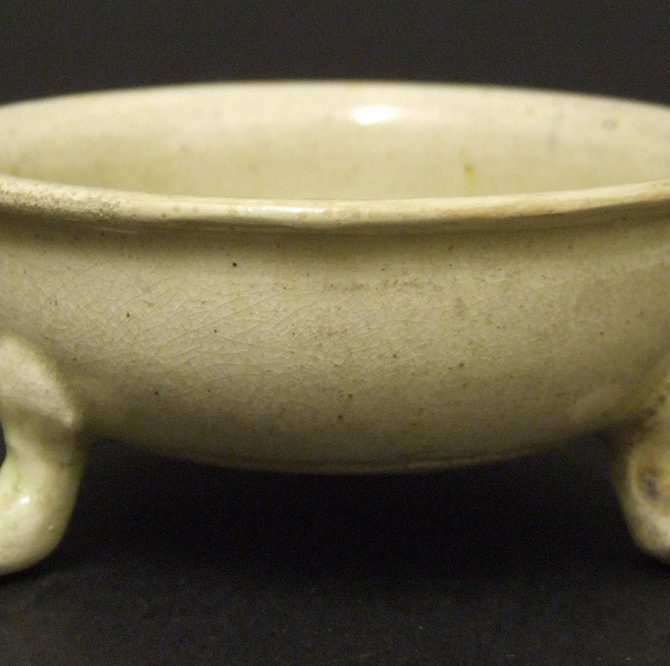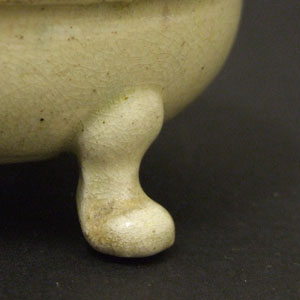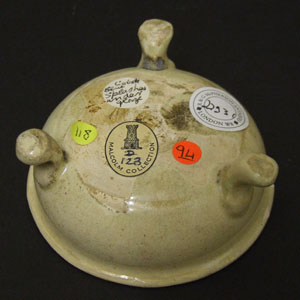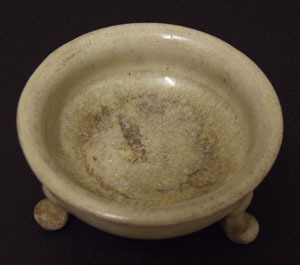
TANG DYNASTY 618 – 906 Tang Pottery
A Tang Pottery Tripod Vessel. The Small Circular Form is Supported on Three Cabriole Legs. The White Pottery Body is Covered with a Transparent Glaze of a Pale Green Hue .
SOLD
- Condition
- Good, two chips to the shallow everted rim, c.9 x 2 mm and c. 2 x 2 mm. The well of vessel is partly degraded, it has iridescence and some staining.
- Size
- Diameter : 7.5 cm (3 inches)
- Provenance
- Sir Neill Malcolm (1869-1953). Label to base, item D 123. Major-General Sir Neill Malcolm was educated at Eaton and Sandhurst, he travelled to China and Tibet in 1896. After the first World War he became head of the British military mission in Berlin. . In 1922 he became Commander-in-Chief in Singapore where he started his hobby. After retiring from the army he was chairman of the China Society and helped found the Oriental Ceramics Society. He also took an active part in promoting the International Exhibition of Chinese Art at the Royal Academy (1935-1936). Information from `Provenance ; Collectors, Dealers & Scholars : Chinese Ceramics in Britain & America` (Roy Davids, Dominic Jellinek, Privately Printed, 2011. ISBN 978-0-9570148-0-0).
- Stock number
- 22931
Information
The PHDS Wikramaratna Collection of Oriental Ceramics and Works of Art.
PHDS Wikramaratna (PH) was born in Ceylon in 1916, coming to London in 1937 where he took a First Class Honours Degree in engineering. He returned to Ceylon at the outbreak of war where he was the first Ceylonese teacher of civil engineering. After settling in the UK with his Dutch-born wife and their family, he gradually built up an extensive collection of Far-Eastern, and mainly Chinese, ceramics, although by no means limited in scope. His antiquities will appear in a later sale. Being in London allowed him to research his finds in the museum showcases, the libraries, the salerooms, and with his many expert friends and acquaintances. As a member of the Oriental Ceramic Society, he often attended meetings and occasionally loaned some of his pieces for OCS exhibitions or gave a lecture. At one time he became a potter to find out more about the techniques used - but according to his wishes, his family has kept these pots. PH had an excellent eye and a feel for the unusual, and his collection contains many pieces which at first glance may appear unexciting but are actually carefully chosen for the ceramics story they have to tell. This sale is an opportunity for both the novice collector and the more experienced. Over the years, PH gave many fine pieces to museums; they can be seen at the British Museum, Victoria and Albert, Ashmolean and Fitzwilliam. PH died in December 2010 and his collection is now coming up for sale. In 1994, Mr Wikramaratna had an inventory taken of the better pieces in the collection and some reference to it has been made in the footnotes, these items have tiny yellow and red numbered stickers.
Since the Tang dynasty (618-906) writers have paid homage to the beauty of white wares leaving tangible evidence of their value. However, the class and refinement displayed in wares of complete whiteness had been sought after hundreds of years before the Tang dynasty and would be cultivated for hundreds of years after its demise. This infatuation generated a variety of white wares which vary in degree of whiteness, refinement of materials, and decoration as a large number of kilns produced white wares even if it was not their specialty. Importantly white wares are not confined to one way of production or from one kiln or geographic area. Until the Southern Song dynasty white wares were considered a product of northern China, however, white wares were still manufactured in the south. Thus, within this commentary, white wares are loosely defined as a body (porcelain or stoneware), slip, glaze, or any combination therein, that creates a white or white-toned ware. Additionally, only a few of the most influential white wares produced during the Song dynasty (960-1279) are discussed as scholars are still debating over the many types of white wares. Future excavation and research hold many exciting discoveries for this discipline.


